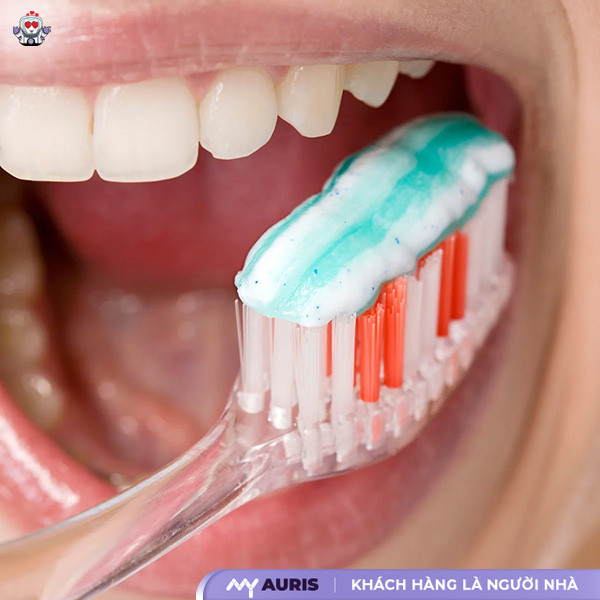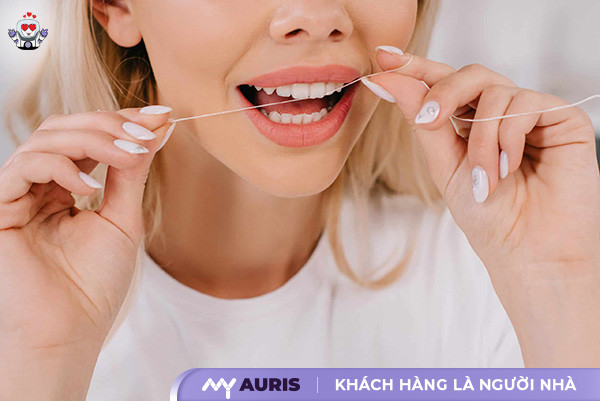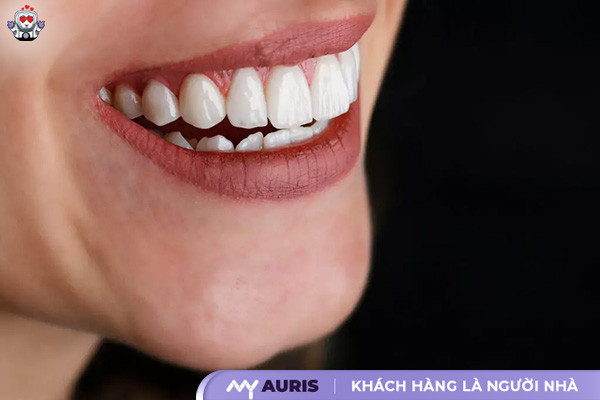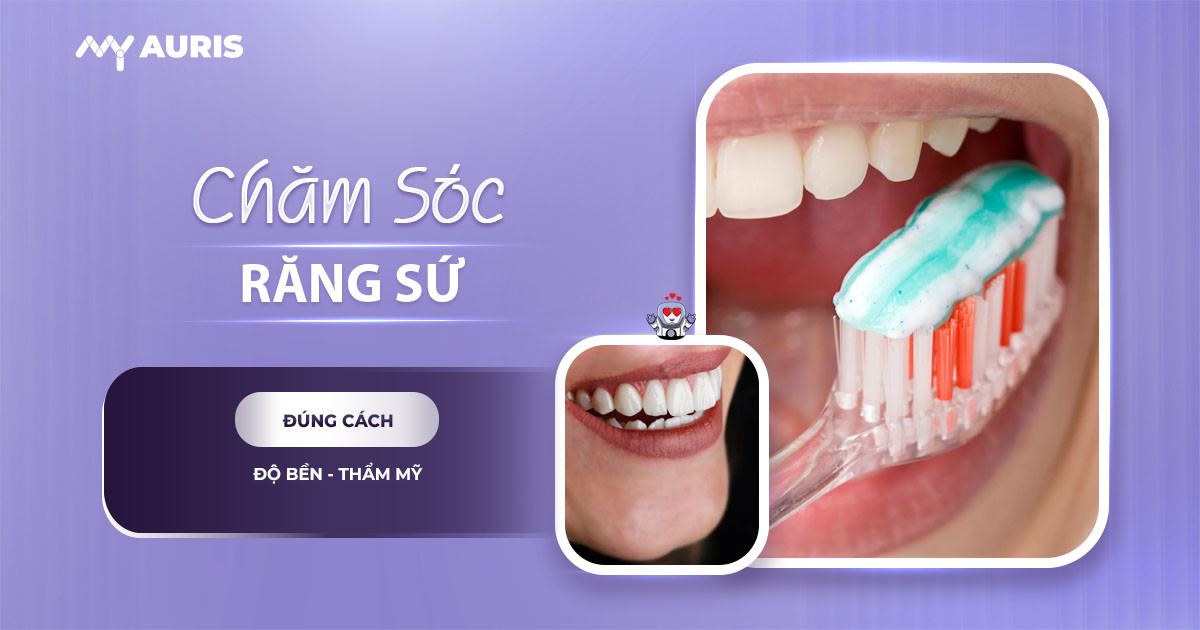After getting porcelain crowns, many people believe that these restorations do not require as meticulous care as natural teeth. However, porcelain crowns can still be damaged if not properly cleaned. To maintain their aesthetics and long-term durability, users need to follow their dentist’s instructions for porcelain crown care. This article will guide you on how to care for porcelain crowns across specific aspects such as diet, hygiene, and regular check-ups.
Why is proper porcelain crown care necessary?
Proper care for porcelain crowns is an essential step to ensure their durability and aesthetic appeal after dental restoration. Although made from high-grade ceramic materials like zirconia or lithium disilicate, porcelain crowns can still be damaged if not properly cleaned and used appropriately.
Porcelain Crowns Are Not Natural Teeth
After placement, many mistakenly believe that porcelain crowns do not need the same attention as natural teeth. In reality, porcelain crowns do not have a living pulp, so if issues like gum inflammation, crown margin exposure, or tooth fracture occur, you won’t feel it immediately. This delays treatment, easily leading to restoration damage or affecting overall oral health.
Neglecting Porcelain Crowns Can Reduce Lifespan and Increase Costs
The average lifespan of porcelain crowns can range from 7 to 15 years if properly cared for. However, if oral hygiene is inadequate or dietary habits are careless, such as chewing ice, using stimulants, or smoking after getting crowns, porcelain crowns can degrade quickly in just a few years. You will then have to incur high costs for replacement or treatment of gum inflammation and gum recession.
Proper Care Helps Maintain Aesthetics and Function
Cosmetic porcelain crowns do not discolor like natural teeth, but if you don’t use a soft-bristled toothbrush, specialized toothpaste, or frequently use alcohol-based mouthwash, the porcelain surface can become scratched, dull, or lose its shine. This diminishes their natural appearance and makes them prone to plaque and bacterial buildup around the gum line.

Porcelain Crowns Still Require Proper Cleaning Like Natural Teeth
After getting porcelain crowns, you need to continue daily oral care routines such as brushing your teeth at least twice a day, using dental floss, interdental cleaning tools, and revisiting the dentist every 6 months. Avoid using toothpaste with strong abrasives, as it can wear down the porcelain surface, leading to minor scratches that are difficult to fix.
Helps Prevent Future Complications
Gum inflammation, exposed crown margins, or gum recession around porcelain crowns are common complications if not properly cared for. Once they occur, treatment involves removing the crown, treating the soft tissue area, and then restoring it – which is both costly and time-consuming.
What to Do After Getting Porcelain Crowns for Quick Stabilization?
During the first 24 hours after getting porcelain crowns, avoid chewing in the area with the new crown. Do not use your tongue or hands to push the teeth, avoid biting fingernails or hard objects. Limit excessive talking or wide mouth opening. Porcelain crowns need time to firmly bond with the cement; displacement can lead to exposed crown margins.

Light Diet
“What to eat after getting porcelain crowns?” is a common question. For the first 1-3 days, you should only eat soft foods such as porridge, soup, eggs, milk, and ripe fruits. Completely avoid hard, excessively hot, or excessively cold foods. Chewy, sticky foods like taffy and glutinous rice cakes should also be temporarily eliminated.
After a few days, when chewing feels stable, you can resume normal eating habits but must still avoid bad habits like chewing ice or opening bottle caps with your teeth. These practices are common causes of porcelain crowns fracturing or becoming loose.
Gentle and Proper Oral Hygiene
After getting porcelain crowns, proper hygiene plays a crucial role. Use a soft-bristled toothbrush, brushing vertically and in gentle circular motions, avoiding harsh scrubbing that can damage the gum area around the crown. Choose a specialized toothpaste without abrasive particles.
Combine with dental floss to clean between teeth and alcohol-free mouthwash to limit bacteria. Absolutely do not skip this step because while porcelain enamel does not decay, the surrounding gums are very susceptible to inflammation if not kept clean.

Monitor Reactions and Attend Follow-up Appointments as Scheduled
If you experience symptoms such as prolonged throbbing pain, sensitivity to hot/cold, exposed crown margins, or an uncomfortable bulky sensation, you need to contact your dental clinic immediately. These could be signs of a loose crown, pulp inflammation, or gum inflammation.
A follow-up appointment after the first week is mandatory. Subsequently, you should maintain a regular check-up schedule every 3–6 months for your dentist to examine the fit, color, and condition of the gums around your porcelain crowns. Early detection of issues makes adjustments much easier.
Eliminate Harmful Habits
Smoking, drinking strong coffee, black tea, and using stimulants are factors that can dull porcelain crowns and make gums prone to inflammation. Quit or minimize these habits. Additionally, if you grind your teeth in your sleep, you should use a nightguard as prescribed by your dentist to protect your porcelain crowns.
How to Properly Clean Porcelain Crowns at Home
After getting porcelain crowns, daily cleaning is not merely brushing; it’s a comprehensive process that requires understanding and correct execution:
Cleaning Porcelain Crowns with a Soft-Bristled Toothbrush
Users should use a soft-bristled toothbrush to avoid scratching the porcelain surface. Toothbrushes should be replaced every 2–3 months. Brush teeth gently in circular motions, avoiding vigorous horizontal scrubbing. Morning and evening are the two most important times to maintain this habit.
For those with full porcelain crowns or porcelain veneers, the porcelain enamel surface is very sensitive to toothpaste containing abrasive particles. Therefore, it is advisable to choose non-abrasive toothpaste without strong bleaching agents. Some specialized toothpastes for sensitive teeth are also suitable for people with porcelain crowns.

Using Dental Floss and Interdental Cleaning Tools
Regular toothbrushes cannot completely clean between teeth. Therefore, using dental floss is mandatory. Choose a soft type of floss that can gently slide through interdental spaces without harming gum tissue. If you’re not accustomed to using floss, you can use a water flosser or a specialized pointed interdental cleaning kit.
Clean between your teeth at least once a day, preferably in the evening after eating. This habit helps prevent plaque accumulation – the main cause of gum inflammation around porcelain crowns.
Using Alcohol-Free Mouthwash
Mouthwash aids in comprehensive oral cavity cleaning. However, alcohol-based types can cause dry mouth and gum irritation. Users should choose an alcohol-free mouthwash with gentle ingredients that helps clean bacteria while remaining safe for the soft tissues around porcelain crowns.
Rinse your mouth twice daily, holding the solution in your mouth for at least 30 seconds. Combined with brushing and flossing, mouthwash will help complete your at-home porcelain crown care routine.

Avoid Actions That Harm Porcelain Crowns
Some seemingly harmless habits can quickly damage porcelain crowns. Individuals with porcelain crowns should not bite their fingernails, chew ice, or open bottle caps with their teeth. Additionally, smoking, drinking black tea, and coffee regularly can cause porcelain crowns to discolor over time.
Porcelain crowns have high resistance to force, but if constantly subjected to strong impacts – especially with excessively hard or sticky foods – they can still chip, crack, or have their crowns dislodged. Therefore, adjusting your diet is necessary to protect your dental restorations.
Regular Check-ups and Assessment of Porcelain Crown Stability
Self-cleaning at home only helps control most bacteria and plaque. However, it’s impossible to fully observe signs of exposed crown margins or root inflammation. Therefore, regular check-ups at a dental clinic every 6 months are mandatory.
The dentist will check the stability of the dental cement, perform a more thorough plaque cleaning with specialized tools, and re-instruct you on the care routine if adjustments are needed. This is also the time to detect problems early before they lead to major complications.
How Do Eating Habits Affect Porcelain Crowns?
After getting porcelain crowns, users should minimize consuming excessively hard foods like ice cubes, bones, and hard candies. These foods can create significant pressure, causing porcelain crowns to crack, chip, or even dislodge if the bonding agent is weak. Furthermore, excessively hot or cold foods should not be consumed frequently because porcelain crowns have average thermal conductivity, which can cause sensitivity, especially for those who have recently had crowns placed.
Dark-colored foods and beverages such as coffee, black tea, red wine, and dishes containing many artificial colorings should also be reduced. Although porcelain crowns do not change color like natural teeth, the porcelain surface can become dull if continuously exposed to dark pigments. Notably, teeth whitening agents are ineffective at brightening the surface of porcelain crowns, so once stained, it is very difficult to restore them to their original appearance.
Smoking or using stimulants are also factors that reduce the durability and aesthetics of porcelain crowns. These substances easily adhere to teeth and gums, creating a favorable environment for bacteria to grow, increasing the risk of gum inflammation around porcelain crowns.

What to Note for Long-Lasting Beautiful Porcelain Crowns?
Porcelain crowns do not get cavities but can still encounter issues such as gum inflammation, gum recession, chipping, or discoloration if not regularly cared for. Users need to understand that porcelain crowns, despite their high durability, still require maintenance like natural teeth to achieve long-term effectiveness:
Proper daily porcelain crown cleaning is the first factor. Using a soft-bristled toothbrush and non-abrasive toothpaste will help prevent scratching the porcelain surface. Prioritize specialized toothpastes for sensitive teeth, avoiding those with abrasive particles. Additionally, daily use of dental floss or interdental cleaning tools is essential to clean plaque where the porcelain crowns meet the gums. It’s advisable to combine this with alcohol-free mouthwash to avoid irritating the soft tissues around the teeth.
Pay attention to daily eating habits. Avoid excessively hard foods like ice cubes, hard candies, or chewy foods, as they can easily cause porcelain crowns to crack or chip. It’s also necessary to limit dark-colored foods and beverages such as coffee, black tea, and carbonated soft drinks to prevent tooth discoloration. During the first week after placement, soft, warm, and easily digestible foods should be eaten. Avoid excessively hot or cold foods to reduce pressure on the artificial tooth enamel and dental cement.
Do not smoke or use stimulants. This is a strict rule to follow because nicotine not only causes yellowing but also weakens porcelain enamel and affects the gums. Additionally, users should control bad habits such as teeth grinding, chewing on one side, or using teeth to open objects. These behaviors can cause the porcelain crown to shift or expose the crown margin.
Regular check-ups every 6 months at a reputable dental clinic are essential. The dentist will check the adhesion of the dental cement, assess the condition of the gums, and adjust the restoration if any issues arise. If signs such as gaps between teeth, prolonged sensitivity, or red gums appear, users should see a dentist immediately for timely treatment, avoiding unwanted complications.
Choosing appropriate oral hygiene products is a way to protect porcelain crowns long-term. Use a small-headed electric toothbrush or a regular toothbrush with soft bristles. Avoid alcohol-based mouthwashes as they can cause dry mouth and irritation. Prioritize products recommended by your dentist and that have medical certification.
Do not overuse teeth whitening agents. Porcelain crowns do not respond to whitening agents like natural teeth; overuse can damage the tissues around the teeth or affect the overall color of the entire dentition. If other teeth need whitening, specific instructions from the dentist are required.
Finally, everyone needs to develop a habit of caring for their porcelain crowns just like natural teeth. This not only helps the restoration maintain its aesthetics long-term but also protects overall oral health. More importantly, it helps avoid additional treatment costs and sustains the results of aesthetic dental treatment.





